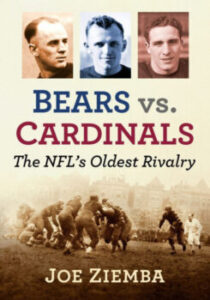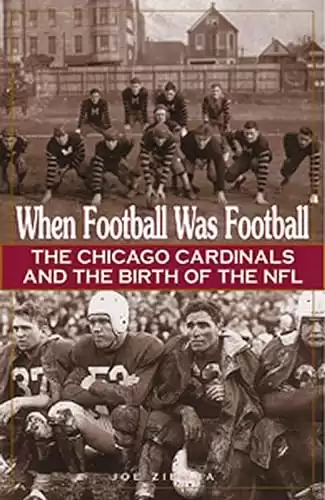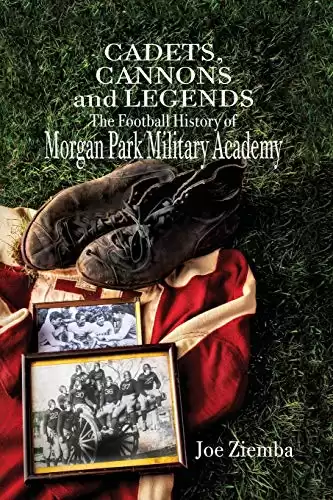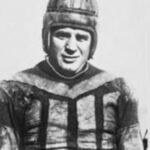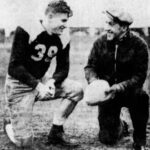As we celebrate our first anniversary of “When Football Was Football” on the Sports History Network, we can look back at a wide variety of episodes from the golden days of football in the Chicago area. While we’ve covered topics such as the first-ever indoor football games held in Chicago, the individual heroics of players such as Charley Trippi, Ernie Nevers, and Paddy Driscoll, as well as intriguing team topics such as the merger of the Cardinals and Steelers in 1943, we’ve never taken the approach of discussing the passion of football fans in the Chicago area.
Football followers in Chicago are a hardy, but loyal breed…quick to complain, but even quicker to defend their favorite team, which now, of course, is none other than the Chicago Bears. But, at one time, Chicago enjoyed the exploits of two NFL teams in the city: The Bears on the north side and the Cardinals on the south side. The rivalry between the two football teams was natural, much like the baseball chasm that still exists between the White Sox and the Cubs.
For years, Chicago’s main sports teams even shared stadiums, with the Cubs and the Bears at Wrigley Field and the White Sox and the Cardinals down south at Comiskey Park. There was one major exception, however, when new Cardinals’ owner Charles Bidwill moved the team into Wrigley Field during the 1930s. This move was made with the hope that the Cardinals would increase their attendance by playing games at the same location as the Bears, who enjoyed superlative support on the north side. It didn’t work, and the Cardinals were soon back on the south side…
Bears Seek Revenge Over Cardinals
In this episode of “When Football Was Football,” we’re going to look a little closer at the rivalry between the two Chicago teams in 1951 when the Bears were near the top of the standings while the Cardinals resided at the bottom. However, in the second game of the season on October 7, 1951, the Cardinals stunned the visiting Bears 28-14 in front of about 34,000 fans at Comiskey Park. After the game, Cardinals’ coach Curly Lambeau, now in his second season with the team, was joyful as he told the Chicago Tribune:
“Happy? Sure I am. I like to beat those Bears. But I’m friends 363 days of the year with George Halas.” The Tribune then added: “There was little but gloom in the Bears’ salon. But one thing was certain—Halas and his people were thinking about December 16. That’s the day the Cards will visit Wrigley Field.”
By December 16, things were much different. The Bears were now 7-4 and could tie for the division title with a win over the Cardinals. The Cardinals, however, were mired in last place with a 2-9 mark and had parted ways with coach Lambeau a week before on December 8. Lambeau resigned on December 7, and vowed to complete the last two games of the season, but wasn’t shy about blasting Cardinals’ management in his closing comments. A day later, he was gone…
On December 9, the Cardinals lost a 20-17 decision to Washington setting up the final game of the campaign against the Bears. Rumors began to swirl that the Cardinals were for sale and the team began interviewing possible coaching candidates to replace Lambeau, including 23-year-old Terry Brennan, the already successful coach at Mt. Carmel High School in Chicago. Brennan would eventually end up as the head coach at Notre Dame in 1954.
War Hero Cheers On Cardinals
With all of these distractions in place for the Cardinals, the team was not expected to present much competition for the Bears on December 16. But as always, the Cards would bring some of their loyal fans with them to the den of their fiercest rival on the north side of Chicago despite the prediction of severe weather. At 7:00 am on the day of the game, the temperature in Chicago dipped to -12 degrees and would remain below zero at game time, establishing a new mark for the coldest December 16 on record in the city.
With snow from a previous storm already blanketing Wrigley Field, conditions were certainly not favorable for either the players or the fans! But some Cardinals’ followers would not let a simple thing like sub-zero weather interfere in their plans to watch their favorite team take on the dangerous Bears! They had already been through much worse during their lifetimes…
This portion of our episode on the 1951 Cardinals’ season finale actually began in April of 1945 when the US 77th Infantry took part in the pivotal Battle of Okinawa. During this key invasion, Chicagoan Phil Schouten of the 77th (who was still a teenager) suffered horrific injuries that took both of his legs above the knees. The US victory in Okinawa helped pave the way for the final Japanese surrender shortly thereafter.
The wounded hero from the Roseland neighborhood on the far south side of Chicago returned home to rebuild his life. According to an article in the Southtown Economist, which stated: “Upon his return to the city in 1945 hundreds of local residents contributed toward purchasing him a new, specially equipped automobile which he could use with artificial limbs.” Phil also had the support of his five other siblings, including two nuns and a Catholic priest who was a missionary in Africa.
After his return, Phil set up his own accounting business, and with his brother, Joe was part of an active group of friends called “The Poker Club Golf Association,” which, as indicated, resulted in numerous sporting activities including bowling. They also loved the Chicago Cardinals!
Joe Schouten helped arrange for the group to attend the Bears/Cardinals game at Wrigley Field on December 16, 1951. It was a date that the neighborhood friends looked forward to and Phil was anxious to be a part of it as well. The only problem was that the stadium did not provide seating accessibility for disabled fans like Phil. Joe told us recently: “We weren’t going without Phil.” So, the group managed to exchange four tickets owned by buddy George Widegrin for eight field passes. Other attendees from that collection of Cardinals’ fans included Ernie Berquist, Pat and Vince Abbeduto, Joe Kopchak, and a rather thin fellow named John Vander Werf. The weather was frigid, as noted previously, with temperatures hovering below zero and the guys “borrowed” some of Phil’s leg coverings to help keep their ears warm!
Trippi Leads Cards' Comeback
Once settled on the field, the group cheered for their Cardinals and were rewarded by a surprising start to the second half. Down 7-0 at the break, the Cardinals reversed that margin quickly as Charley Trippi became an inspired wrecking crew for the Cardinals as reported by the Chicago Tribune:
The old Eskimo from Georgia and Pennsylvania, Charles Lou Trippi, yesterday was the hottest person, man, woman, or child, in Wrigley Field, a refrigerator registering one below zero. No one thought to tell Charley that it wasn’t a day fit for football when he went into action with the Cardinals trailing the Bears as the second half began 7-0.
In this frigid setting, Trippi became a one-man show. In his greatest pro afternoon, he ran 13 times for 145 yards, scored two touchdowns, and passed for the other one in completing nine of 20 passes for 106 yards in a 24-14 triumph.
With the loss, the Bears watched as their title hopes vanished, but that was not the only thing that vanished from Wrigley Field that day…
Cardinals' Fans Evade Halas' Security Guards
During the Cardinals’ victory, a wayward punt landed near the Schouten group adjacent to the field. Being inquisitive south siders, the boys from Roseland decided to have some fun, grab the football, and hide it from the Bears’ security guards. Knowing the reputation of Bears’ owner George Halas for financial tightness made the escapade even more enjoyable! But how do you hide a football? Soon Bears’ personnel were scouring the immediate area while the Schouten brothers and their friends focused on the game. No one, it appeared, had the slightest idea where the ball was!
Joe Schouten recalled the situation: “We knew that Bears’ owner George Halas was very frugal and that the security guards were determined to find that ball. They kept looking at my brother, Phil, and figured that he was hiding it in his wheelchair.” When Phil pulled back his blankets and reluctantly proved that he was not hiding the football, the guards were perplexed and gave up the search and began looking elsewhere. George Halas would not be happy if that football was lost!
Eventually, through some sleight of hand among the friends, the football ended up under the belt and overcoat of the very skinny Vander Werf who was nicknamed “Slim” for good reason. He was very slight of stature and the football under his belt might simply resemble an emerging beer belly to any inquisitive security guards! Joe Schouten added: “No one ever suspected that the skinny guy would have it!” And so, the group slipped out of Wrigley Field that day and kept the ball…and kept it…and kept it…and kept it.
Later, someone had the game score and date inscribed on the football and over the years, it was proudly displayed and shared among the original eight friends from that day—each telling the story about how they were able to evade the determined Halas security patrol during the Cardinals’ monumental upset victory on a frozen day back in 1951.
And while the numbers of “The Poker Club Golf Association” membership have thinned over the last seven decades, the ball lives on as a fond memory of a very special group of friends, who were Cardinals’ fans, veterans, and heroes.
A photo of the infamous football accompanies this article, along with a great photo of Joe Schouten (now a spry 98) with his late wife June and the football. We have also included a photo of Phil and Joe Schouten taken in May of 2021. I am very grateful that Joe has entrusted this football to myself to be displayed at our various Chicago Cardinals’ programs around the country. Thanks also to Joe’s gracious daughter Lynn, who introduced us a few years ago and has made it possible for football fans around the world to learn about the inspired friendship of the Schouten brothers and the “The Poker Club Golf Association.”
Thank you for spending part of your day with us and we look forward to our next episode on the Sports History Network which will focus on one of the more familiar names in pro football history: Ernie Nevers. Nevers was a Hall of Fame member of the Chicago Cardinals and a major league pitcher, but we’ll share with you the unusual story of his very first professional football game, which was not with an NFL team…
All photos courtesy of the Schouten family.
Author and Host - Joe Ziemba
Joe Ziemba is the host of this show, and he is an author of early football history in the city of Chicago.
Here, you can learn more about Joe and When Football Was Football, including all of the episodes of the podcast.
Joe Ziemba is the host of this show, and he is an author of early football history in the city of Chicago. Here, you can learn more about Joe and When Football Was Football, including all of the episodes of the podcast.
Please Note – As an Amazon Associate I earn from qualifying purchases
Resources
More From When Football Was Football
Paddy Driscoll’s Almost Perfect Season
Back at the beginning of the National Football League in...
Read More120,000 Fans Witness High School Football Game in 1937!!!
Let’s set the stage… It was a warm November afternoon...
Read MoreIn The Beginning: An Interview With Joseph T. Sternaman
And, you may ask, who is Joseph T. Sternaman? Sternaman...
Read More1948: The Last Hurrah of the Chicago Cardinals
Cardinals’ fans are familiar with the long, sad story concerning...
Read More


